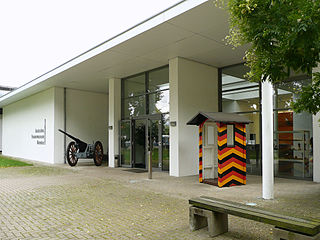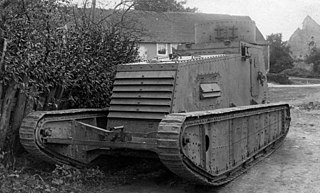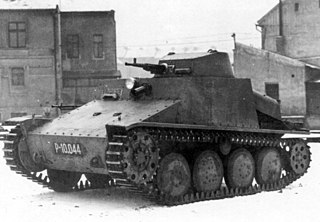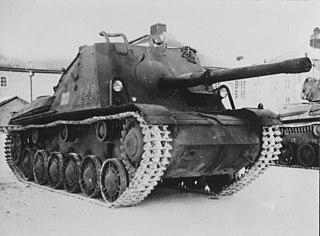
The Panzerkampfwagen 38(t), originally known as the ČKD LT vz. 38, was a tank designed during the 1930s, which saw extensive service during World War II. Developed in Czechoslovakia by ČKD, the type was adopted by Nazi Germany following the annexation of Czechoslovakia. With the German Army and other Axis forces, the type saw service in the invasions of Poland, France and the USSR. Production ended in 1942, when its main armament was deemed inadequate. In all, over 1,400 Pz. 38(t)s were manufactured. The chassis of the Pz. 38(t) continued to be produced for the Marder III (1942–1944) with some of its components used in the later Jagdpanzer 38 (1944–1945) tank destroyer and its derivative vehicles.

The Stridsvagn 103, also known as the Alternative S and S-tank, is a Swedish Cold War-era main battle tank, designed and manufactured in Sweden. "Strv" is the Swedish military abbreviation of stridsvagn, Swedish for chariot and tank, while the 103 comes from being the third tank in Swedish service to be equipped with a 10.5 cm gun.

The Centurion was the primary British Army main battle tank of the post-World War II period. Introduced in 1945, it is widely considered to be one of the most successful post-war tank designs, remaining in production into the 1960s, and seeing combat into the 1980s. The chassis was adapted for several other roles, and these variants have remained in service. It was a very popular tank with good armour, mobility, and a powerful main armament.

The Bofors 37 mm anti-tank gun was an anti-tank gun designed by Swedish manufacturer Bofors in the early 1930s originally for Swedish use. It was exported to several countries during the 1930s of which several bought licences to produce it themselves. The gun was used in several conflicts but most of its fame comes from its use in the Spanish Civil War and the Winter War where it was used very successfully against light tanks and armored cars among other targets. Beyond its use as an infantry gun it was also used as the main armament in several armored cars and tanks such as the Dutch M39 Pantserwagen and the Polish 7TP to name a few. As the armor of tanks was increased during World War II the gun very quickly became obsolete as an anti-tank gun but was still used effectively as an infantry support gun for the entirety of the war, and well into the Cold War. This was due to its high fire rate, great mobility and effective high explosive shells.

Stridsvagn 122 is a Swedish main battle tank that, like the German Leopard 2A5, is based on the German Leopard 2 improved variant utilizing such newer technology as command, control, and fire-control systems, reinforced armour, and long-term combat capacity. Externally, the vehicle is distinguished from the Leopard 2A5 by the French GALIX smoke dispensers, different storage bins, and the thicker crew hatches.

Stridsvagn 74 was a Swedish light tank in use with the Swedish Army from 1958 to 1984. It was a modification of the older stridsvagn m/42 medium tank, which was phased out of service in the early 1950s. Instead of scrapping the vehicles altogether, the chassis were used to build a new tank which could be used as a supplement to the newly bought stridsvagn 81. The turret of the strv 74 was completely new, with a 75 mm high-velocity gun based on an older anti-aircraft gun Bofors 75 mm Model 1929, engines and transmission were modified or changed from the strv m/42, wider tracks and a separate electrical motor for turret traverse was introduced while retaining manual traverse as a backup.

The German Tank Museum is an armoured fighting vehicle museum in Munster, Germany, the location of the Munster Training Area camp. Its main aim is the documentation of the history of German armoured troops since 1917.

Stridsvagn m/41 was a Swedish medium tank. A license-built version of the Czechoslovak TNH medium tank, it served into the 1950s.

The Leichter Kampfwagen or "LK I" was a German light tank prototype of the First World War. Designed to be a cheap light tank as opposed to the expensive heavies coming into service at the time, the tank only reached the prototype stage before the end of the war.

Stridsvagn m/42 was a Swedish medium tank in service in the World War II period. Known by its manufacturer AB Landsverk as Lago II-III-IV, it fielded a 75 mm L/31 gun, the first of its size in a Swedish tank. It entered service with the Swedish Army in April 1943. Modern in design and mobile, a total of 282 were produced.

The Landsverk L-60 was a Swedish tank developed in 1934. It was developed by AB Landsverk as a light tank which included several advanced design features such as torsion bar suspension, periscopes rather than view slits and all-welded construction.

Stridsvagn m/37 was a Swedish-built version of the Czechoslovak ČKD AH-IV tankette.

The AH-IV was a Czechoslovak-designed export armored fighting vehicle, classed as either a tankette or light tank, used by Romania during World War II, but having also been acquired by neutral Sweden and Iran. Modified AH-IV versions were built under license by Romania (R-1) and Sweden. The Romanian vehicles saw action on the Eastern Front from Operation Barbarossa to the Vienna offensive. Twenty vehicles were sold after the war to Ethiopia, who used them until the 1980s.

Landsverk L-10 was a Swedish late interwar era medium tank constructed by AB Landsverk for the Swedish Army between 1930 and 1933.

This article deals with the history of tanks employed by military forces in Czechoslovakia from the interwar period, and the more conventional tanks designed for the Czechoslovak Army before World War II, and the tanks that ended up as Panzers of the German Wehrmacht during World War II, or in the use of other countries who purchased them before the war began.

This article deals with the history and development of tanks employed by the military of Sweden, from the interwar period, and World War II, the Cold War and modern era.

The Pansarvärnskanonvagn m/43 was a tank destroyer developed by Landsverk.

Landsverk L-30 was a Swedish late interwar era medium tank constructed by AB Landsverk for the Swedish Army between 1930 and 1935, featuring welded armour joints and a "wheel-cum-track system", allowing for interchangeable wheeled and tracked propulsion.


















